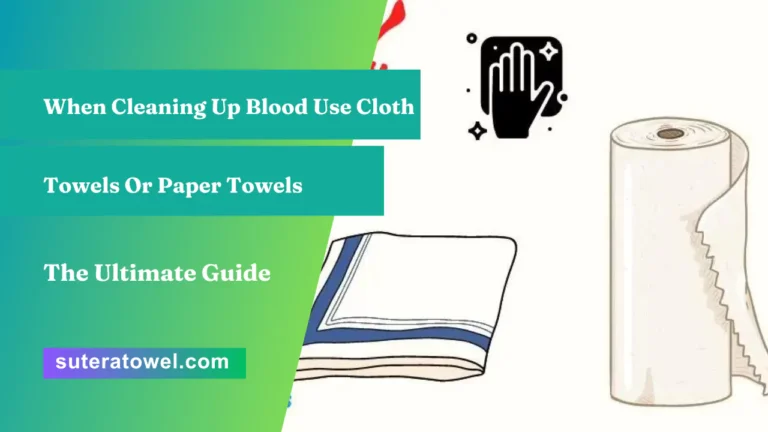To clean up blood, cloth towels are preferred over paper towels due to their absorbent properties and ability to effectively clean the affected area without leaving any residue. Cleaning up blood can be a challenging task, especially when it comes to ensuring proper hygiene and safety.
Whether it’s at home or in a medical setting, using the right tools for the job is crucial. When it comes to blood cleanup, the choice between cloth towels or paper towels is important. Cloth towels are often the preferred option due to their absorbent properties and the ability to effectively clean the affected area without leaving any residue.
In contrast, paper towels may not have the same level of absorbency and may leave behind particles or fibers, which can hinder proper cleaning. Ultimately, choosing cloth towels for blood cleanup helps ensure a thorough and hygienic process.
The Advantages Of Cloth Towels
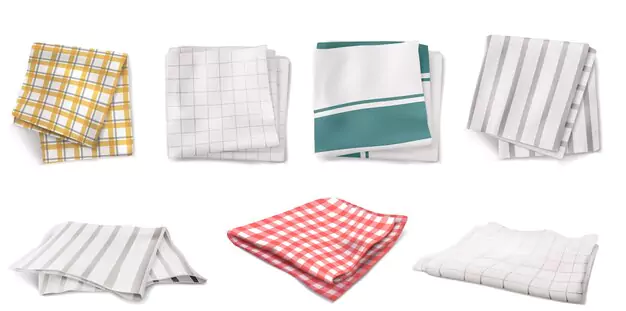
Cloth towels offer numerous advantages over paper towels when cleaning up blood. They are more absorbent, reusable, and eco-friendly, making them a more sustainable choice for effective and hygienic cleanup.
Absorbency Of Cloth Towels
- Cloth towels are known for their exceptional absorbency, making them an ideal choice for cleaning up blood spills.
- Unlike paper towels, which may let blood seep through or smear, cloth towels effectively soak up and contain the spill, minimizing the chance of spreading contamination.
- The absorbent fibers in cloth towels quickly wick away the liquid, preventing it from spreading onto other surfaces.
Reusability Of Cloth Towels
- One of the key advantages of using cloth towels for cleaning up blood is their reusability.
- Unlike disposable paper towels that are thrown away after use, cloth towels can be washed, sterilized, and used again, making them a cost-effective choice in the long run.
- By reusing cloth towels, you not only save money but also reduce environmental waste by minimizing the use of single-use paper products.
How Cloth Towels Minimize Waste
- Cloth towels contribute to waste reduction due to their reusable nature.
- Instead of using multiple paper towels to clean up blood spills, a single cloth towel can be used repeatedly, minimizing the waste generated.
- By choosing cloth towels over paper towels, you help reduce the demand for paper production, which in turn conserves natural resources and reduces pollution associated with the manufacturing process.
Cloth towels offer several advantages when it comes to cleaning up blood spills. Their exceptional absorbency ensures efficient containment of the spill, while their reusability makes them a cost-effective and eco-friendly choice. By opting for cloth towels, you minimize waste and contribute to a more sustainable approach to cleaning.
The Benefits Of Paper Towels
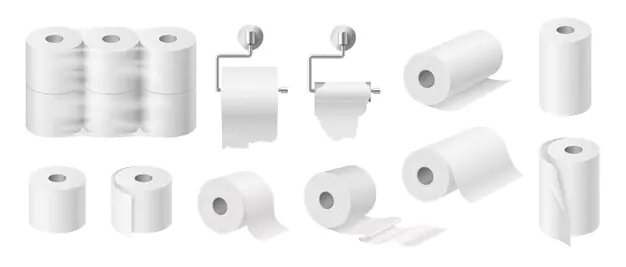
When cleaning up blood, using paper towels offers several benefits, including their absorbency, disposable nature, and the ability to prevent the spread of germs. They make the clean-up process quick and efficient while minimizing the risk of contamination.
Convenience And Disposability Of Paper Towels:
- Paper towels offer exceptional convenience in cleaning up blood as they are readily available in most households and commercial environments.
- They can be easily stored in multiple locations throughout the space, ensuring quick access when needed.
- With their disposable nature, paper towels eliminate the hassle of laundering cloth towels, saving time and effort.
Use Of Paper Towels In Sensitive Environments:
- In sensitive environments such as healthcare facilities, paper towels provide a hygienic solution for cleaning up blood spills.
- Their single-use design minimizes the risk of cross-contamination between different areas or individuals.
- Paper towels are often preferred in environments where biohazard disposal is required, providing a safe and convenient option for managing potentially infectious materials.
The Effectiveness Of Paper Towels In Absorbing Blood:
- Paper towels excel in absorbing blood due to their absorbent fibers and porous structure.
- The texture of paper towels allows for efficient absorption of liquids, preventing the spread of blood stains or contamination.
- The absorbency of paper towels prevents the blood from seeping through the towel, ensuring thorough cleaning and minimizing the risk of surface contamination.
Paper towels offer numerous benefits when it comes to cleaning up blood. Their convenience, disposability, and effectiveness in absorbing blood make them an ideal choice for various settings, including sensitive environments. Whether it is for everyday spills or in healthcare facilities, paper towels provide a practical solution for maintaining cleanliness and hygiene.
Comparing Cloth And Paper Towels For Blood Cleanup
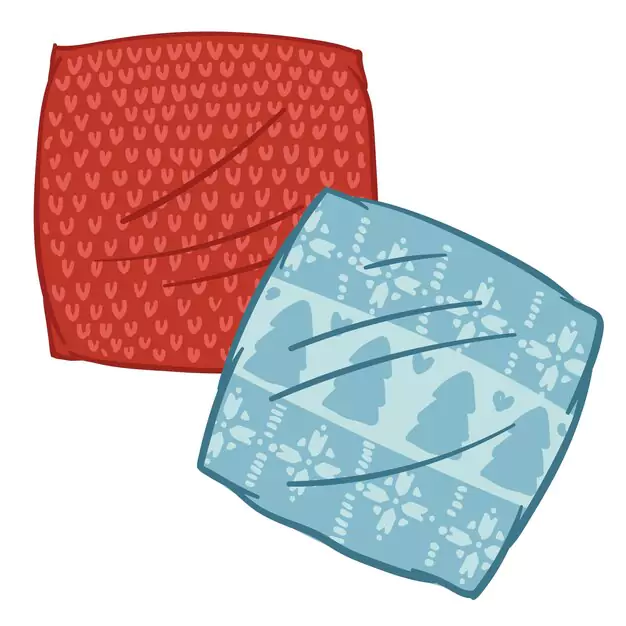
Cloth towels and paper towels each have their own benefits when it comes to cleaning up blood. Cloth towels are reusable and more absorbent, while paper towels are disposable and easier to dispose of. Ultimately, the choice depends on personal preference and specific cleaning needs.
When it comes to cleaning up blood, choosing between cloth towels or paper towels can make a significant difference in terms of cost-effectiveness and health and safety considerations. Understanding the factors to consider when making this decision is crucial for ensuring effective and efficient cleanup.
In this section, we will compare cloth and paper towels for blood cleanup, examining the cost-effectiveness and health and safety aspects associated with each option.
Factors To Consider When Choosing Between Cloth And Paper Towels:
- Absorbency: Cloth towels are generally more absorbent than paper towels, making them a better choice for cleaning up larger blood spills or stains.
- Reusability: Cloth towels can be washed and reused multiple times, making them a more environmentally friendly and cost-effective option in the long run.
- Convenience: Paper towels are convenient as they can be easily disposed of after use, eliminating the need for washing and sanitizing cloth towels.
- Availability: Paper towels are readily available in most households and commercial settings, making them a convenient choice for immediate cleanup.
- Quality: Cloth towels, particularly those made from microfiber materials, tend to be more durable and effective in lifting and trapping blood stains compared to paper towels.
Cost-Effectiveness Of Cloth vs. Paper Towels:
- Cloth towels are a cost-effective option in the long run as they can be reused multiple times, reducing the need for frequent purchases of disposable paper towels.
- While paper towels may seem initially cheaper, the cumulative cost of continually purchasing disposable options can add up significantly over time.
- Cloth towels also eliminate the environmental impact associated with the production and disposal of disposable paper towels.
Health And Safety Considerations When Cleaning Up Blood:
- Cloth towels can pose a higher risk of cross-contamination if not properly cleaned and sanitized after use. It is essential to follow proper laundering procedures, including using bleach or a sanitizing agent, to eliminate any potentially harmful pathogens.
- Paper towels offer a convenient and hygienic solution, as they can be disposed of immediately after use.
- It is crucial to use personal protective equipment (PPE) such as gloves and masks when cleaning up blood to minimize the risk of exposure to bloodborne pathogens.
Choosing between cloth and paper towels for blood cleanup involves considering factors such as absorbency, reusability, convenience, availability, and quality. While cloth towels are cost-effective in the long run and generally more absorbent, paper towels offer convenience and hygienic disposal options.
Health and safety considerations, including proper laundering and the use of PPE, should also be taken into account when deciding on the most suitable option for blood cleanup.
Best Practices For Cleaning Up Blood
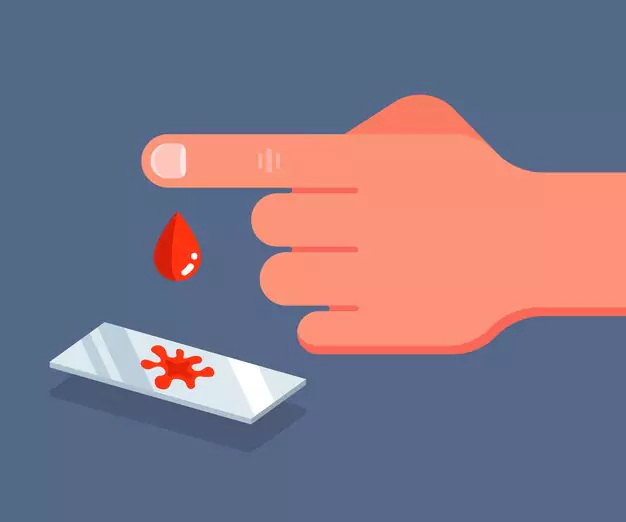
When cleaning up blood, it is best to use cloth or paper towels for effective results. These options are efficient in absorbing the blood and ensuring a thorough cleanup process.
When it comes to cleaning up blood, following proper procedures is essential for safety and hygiene. Whether you are dealing with a small cut or a larger spill, here are the steps to take, safety precautions to follow, and how to dispose of the contaminated materials.
Steps To Take When Cleaning Up Blood:
- Put on gloves: Before you begin cleaning, it’s crucial to protect yourself by wearing disposable gloves. This will prevent direct contact with the blood and reduce the risk of exposure to pathogens.
- Remove any visible objects: If there are any visible objects or debris in the area, remove them carefully using tools like clamps or tongs. Be cautious not to puncture or cut yourself in the process.
- Blot the blood: If the blood has dried, dampening a cloth towel or paper towel with water or a disinfectant solution can help ease blotting. Blot the area gently, starting from the outer edges and working towards the center to avoid spreading the blood.
- Use an appropriate cleaning solution: For cleaning up blood, it’s recommended to use a mixture of one part bleach to ten parts water or a hospital-grade disinfectant. Apply the solution to the affected area, following the product instructions.
- Scrub and clean: Using a clean cloth towel or disposable paper towel, scrub the area thoroughly to eliminate any remaining traces of blood. Again, work from the outer edges towards the center.
- Rinse and dry: After cleaning, rinse the area with clean water to remove any residue from the cleaning solution. Finally, pat dry with a fresh cloth towel or allow it to air dry.
Safety Precautions To Follow:
- Always wear gloves: As mentioned earlier, wearing gloves is crucial to protect yourself from potential bloodborne pathogens. Make sure you dispose of the gloves properly after use.
- Handle sharps with care: If there are any sharp objects, such as broken glass or needles, use appropriate tools to pick them up, avoiding direct contact. Dispose of sharps in puncture-resistant containers.
- Avoid splashing or spraying: While cleaning, be careful not to create droplets or aerosols that could potentially spread bloodborne pathogens. Use gentle cleaning techniques to minimize the risk.
- Wash hands thoroughly: Once you have finished cleaning up, remember to wash your hands thoroughly with soap and warm water for at least 20 seconds. This will ensure any potential contamination is removed.
Proper Disposal Of Contaminated Materials:
- Place all used cloths or paper towels in a leak-proof plastic bag: To prevent the spread of contamination, carefully gather all used cleaning materials, such as cloth towels or paper towels, and place them in a sturdy, leak-proof plastic bag.
- Seal the bag and label it appropriately: Once all the contaminated materials are inside the bag, seal it tightly to minimize any potential leakage. Additionally, label the bag clearly as “Biohazard” or “Infectious Waste” to alert others of its contents.
- Follow local regulations for disposal: Proper disposal of biohazard waste varies by location, so it’s essential to follow local guidelines and regulations. Contact your local health department or waste management facility for specific instructions on how to dispose of the bag safely.
Remember, when cleaning up blood, prioritize personal safety by wearing gloves, following proper cleaning procedures, and disposing of contaminated materials correctly. By adhering to these best practices, you can effectively clean up blood while minimizing the risk of exposure to bloodborne pathogens.
Additional Considerations

When cleaning up blood, it is important to consider whether to use cloth towels or paper towels. Each option has its own advantages and disadvantages, so it is crucial to weigh these factors before making a decision.
When dealing with the cleanup of blood, it is important to take additional considerations to ensure a safe and thorough process. This includes using gloves and other protective gear, properly cleaning and sanitizing cloth towels, and preventing cross-contamination during cleanup.
Let’s delve into these points in detail:
The Importance Of Using Gloves And Other Protective Gear:
- Wear gloves: Always put on disposable gloves before starting the cleanup process.
- Protective clothing: Consider wearing aprons or disposable gowns for added protection.
- Eye protection: Use goggles or protective glasses to shield your eyes from potential splatter or aerosols.
- Face masks: When handling potentially infectious material, wearing a face mask can help prevent inhalation of airborne particles.
- Dispose of properly: After completing the cleanup, carefully remove and dispose of gloves, clothing, and other protective gear to prevent any spread of contaminants.
How To Properly Clean And Sanitize Cloth Towels:
- Immediate removal: Promptly remove any cloth towels that come into contact with blood or bodily fluids.
- Pre-rinse: Rinse the soiled towels with cold water to remove excess blood.
- Cleaning solution: Prepare a cleaning solution by mixing equal parts water and bleach or using a commercially available blood and body fluid spill kit.
- Soak and launder: Submerge the towels in the cleaning solution and let them soak for at least 10 minutes. Afterward, launder the towels using hot water and detergent.
- Drying: Thoroughly dry the towels using high heat in a dryer or by hanging them outdoors in direct sunlight.
- Storage: Store the cleaned towels in a designated area, separate from uncontaminated items, until they are ready to be used again.
Tips For Preventing Cross-Contamination During Cleanup:
- Containment: Use barriers such as plastic sheets or absorbent pads to limit the spread of blood and bodily fluids.
- Avoid direct contact: Minimize contact with surfaces not directly involved in the cleanup process.
- One-time use: Dispose of cleaning materials (e.g., wipes, sponges) after single use to prevent cross-contamination.
- Clean from the least contaminated area: Start cleaning from the outer edges towards the center of the contaminated area.
- Disinfect cleaning tools: Thoroughly clean and disinfect all equipment used during cleanup, including buckets, mops, and brushes.
- Systematic approach: Follow a step-by-step process to ensure all affected areas are properly cleaned and sanitized.
By following these additional considerations, you can maintain a safe and hygienic environment while cleaning up blood. Remember to prioritize safety by using gloves and other protective gear, properly clean and sanitize cloth towels, and take necessary measures to prevent cross-contamination.
Frequently Asked Questions For When Cleaning Up Blood Use Cloth Towels Or Paper Towels
Is It Better To Clean Up Blood With Cloth Towel Or Paper Towel?
It is better to clean up blood with a paper towel as it is more absorbent.
When Cleaning Up Blood What Should You Use?
To clean up blood, you should use a disinfectant specifically designed for blood spills.
What Kind Of Towel Do You Use For Bloodborne Pathogens?
Use a bloodborne pathogens towel to ensure safety and hygiene during clean-up.
When Cleaning Up Blood What Is The Most Important Action You Can Take?
The most important action when cleaning up blood is to handle it with caution to avoid any health risks.
Conclusion
Although cleaning up blood is a task no one wants to face, it is important to approach it correctly for the sake of safety and hygiene. Cloth towels and paper towels both have their advantages and disadvantages when it comes to cleaning up blood spills.
Cloth towels offer absorbency and durability, making them suitable for larger spills and repeated usage. On the other hand, paper towels are more hygienic as they can be disposed of after use. Ultimately, the choice between the two depends on the situation and personal preference.
Regardless of the type of towel used, it is crucial to follow proper safety protocols when cleaning up blood. This includes wearing gloves, using a disinfectant, and properly disposing of any contaminated materials. By doing so, we can minimize the risk of spreading infections and ensure a clean and safe environment.
Remember, when it comes to cleaning up blood, it’s better to be safe than sorry. Take the necessary precautions and choose the right tools for the job. Stay safe and maintain a healthy living space.
